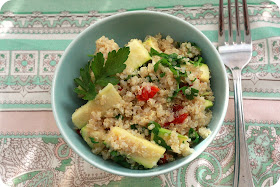 |
| Image: Christian Guthier |
- Protein: Quinoa has a higher protein content than barley, oat, rice and maize(1). Due to a property of its storage proteins, quinoa is a safe gluten-free option(2). According to the FAO and WHO, quinoa protein can supply over 180 percent of the daily recommended intake of the 10 essential amino acids for adult nutrition(3).
- Carbohydrate and Fibre: Quinoa contains 10 percent total dietary fibre(4). Dietary fibre is essential for digestive health, and can promote satiety, reduce cholesterol absorption, and reduce risk and severity of gastrointestinal infection and inflammation(5). Its soluble fibre content also serves as a prebiotic(6).
- Lipids: Quinoa seed oil contains polyunsaturated fatty acids (PUFAs) with a higher omega-6 to omega-3 ratio than other plant oils(7). Other essential fatty acids in quinoa contribute to brain development, insulin sensitivity, cardiovascular health, immunity, inflammation and membrane function(8). These fatty acids may exert beneficial physiological effects as well(9).
- Vitamins: Quinoa is rich in Vitamins A, B, C and E. These vitamins play a major role in metabolism, regulating cell growth and development, and improving vision(10).
- Minerals: Quinoa contains sufficient amounts of calcium, copper, iron, magnesium, phosphorus, potassium and zinc. Its mineral content is higher than that of rice, wheat and other cereals(11).
- Saponins: Saponins, found in the outer seed coat of quinoa, are useful in producing organic crops because they protect crops from microbial infection and from being eaten by insects and birds.
- Phytoecdysteroids: Found in quinoa, phytoecdysteroids can help build muscle and reduce stress(12). Other benefits include promoting growth, healing wounds and serving as an antioxidant and antidepressive(13).
- Phenolics: Phenolics are compounds found in quinoa that serve as antioxidants and have anti-inflammatory, anticancer, antidiabetic, anti-obesity and cardioprotective effects(14).
- Betalains: Betalains are what give quinoa their yellow, red and black colors(15). They contain a range of health-promoting properties and serve as a natural dye for foods. Betalains are approved by the US FDA and EU as a safe, natural alternative to synthetic color ingredients in foods.
- Glycine betaine: Glycine betaine is an amino acid in quinoa that has been involved in the treatment and prevention of diabetes, obesity and cardiovascular disease(16).
 |
| Image: Jennifer |
- Wright and others 2002; Repo-Carrasco and others 2003; Comai and others 2007; Abugoch James 2009; Jancurová and others 2009; Peiretti and others 2013
- Zevallos and others 2014
- Wright and others 2002; Abugoch James 2009; Vega-Galvez and others 2010; Miranda and others 2012b
- Lamothe and others 2015
- Brownawell and others 2012; De Carvalho and others 2014
- Biesiekierski and others 2013
- Tang and others 2015a
- Kim and others 2006; McCusker and Grant-Kels 2010; Vega-Galvez and others 2010
- Calder 2012
- Fitzpatrick and others 2012
- Bhargava and others 2006
- Báthori 2002
- Lafont and Dinan 2003; Dinan and Lafont 2006; Dinan 2009
- Harborne and Williams 2000; Da-Silva and others 2007; Kelly 2011; Jeong and others 2012
- Bhargava and others 2006
- Olthof and Verhoef 2005
Visit the IFT site HERE.
The Global Miller
This blog is maintained by The Global Miller staff and is supported by the magazine GFMT
which is published by Perendale Publishers Limited.
For additional daily news from milling around the world: global-milling.com

No comments:
Post a Comment